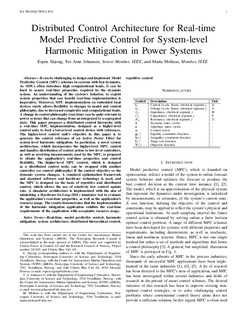| dc.contributor.author | Skjong, Espen | |
| dc.contributor.author | Johansen, Tor Arne | |
| dc.contributor.author | Molinas Cabrera, Maria Marta | |
| dc.date.accessioned | 2019-11-25T10:27:33Z | |
| dc.date.available | 2019-11-25T10:27:33Z | |
| dc.date.created | 2019-04-21T19:59:51Z | |
| dc.date.issued | 2019 | |
| dc.identifier.issn | 0019-0578 | |
| dc.identifier.uri | http://hdl.handle.net/11250/2630211 | |
| dc.description.abstract | It can be challenging to design and implement Model Predictive Control (MPC) schemes in systems with fast dynamics. As MPCs often introduce high computational loads, it can be hard to assure real-time properties required by the dynamic system. An understanding of the system’s behavior, to exploit system properties that can benefit real-time implementation is imperative. Moreover, MPC implementations on embedded local devices rarely allows flexibility to changes in model and control philosophy, due to increased complexity and computational loads. A change in control philosophy (run-time) can be quite relevant in power systems that can change from an integrated to a segregated state. This paper proposes a distributed control hierarchy with a real-time MPC implementation, designed as a higher-level control unit, to feed a lower-level control device with references. The higher-level control unit’s objective in this paper is to generate the control reference of an Active Power Filter for system-level harmonic mitigation. In particular, a novel system architecture, which incorporates the higher-level MPC control and handles distribution of control action to low-level controllers, as well as receiving measurements used by the MPC, is proposed to obtain the application’s real-time properties and control flexibility. The higher-level MPC control, which is designed as a distributed control node, can be swapped with another controller (or control philosophy) if the control objective or the dynamic system changes. A standard optimization framework and standard software and hardware technology is used, and the MPC is designed on the basis of repetitive and distributed control, which allows the use of relatively low control update rate. A simulator architecture is implemented with the aim of mimicking a Hardware-In-Loop (HIL) simulator test to evaluate the application’s real-time properties, as well as the application’s resource usage. The results demonstrates that the implementation of the harmonic mitigation application exhibits the real-time requirements of the application with acceptable resource usage. | nb_NO |
| dc.language.iso | eng | nb_NO |
| dc.publisher | Elsevier | nb_NO |
| dc.rights | Attribution-NonCommercial-NoDerivatives 4.0 Internasjonal | * |
| dc.rights.uri | http://creativecommons.org/licenses/by-nc-nd/4.0/deed.no | * |
| dc.title | Distributed control architecture for real-time model predictive control for system-level harmonic mitigation in power systems | nb_NO |
| dc.type | Journal article | nb_NO |
| dc.type | Peer reviewed | nb_NO |
| dc.description.version | acceptedVersion | nb_NO |
| dc.source.journal | ISA transactions | nb_NO |
| dc.identifier.doi | 10.1016/j.isatra.2019.01.043 | |
| dc.identifier.cristin | 1693282 | |
| dc.relation.project | Norges forskningsråd: 241205 | nb_NO |
| dc.relation.project | Norges forskningsråd: 223254 | nb_NO |
| dc.description.localcode | © 2019. This is the authors’ accepted and refereed manuscript to the article. Locked until 12.2.2021due to copyright restrictions. This manuscript version is made available under the CC-BY-NC-ND 4.0 license http://creativecommons.org/licenses/by-nc-nd/4.0/ | nb_NO |
| cristin.unitcode | 194,63,25,0 | |
| cristin.unitname | Institutt for teknisk kybernetikk | |
| cristin.ispublished | true | |
| cristin.fulltext | postprint | |
| cristin.qualitycode | 1 | |

